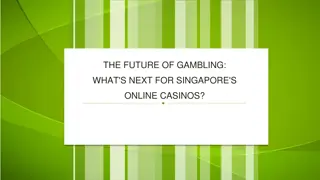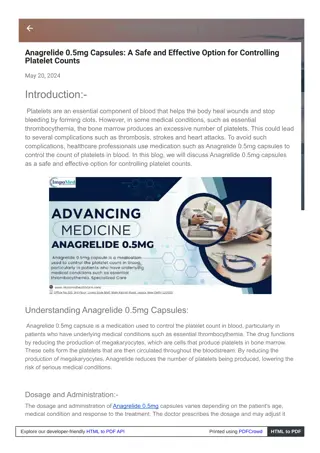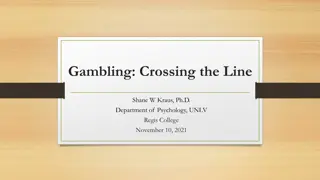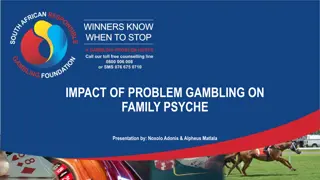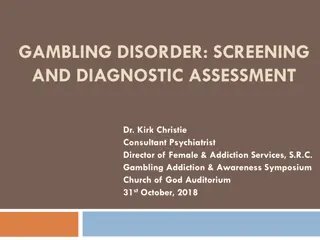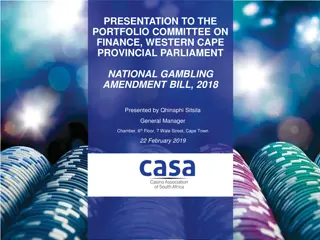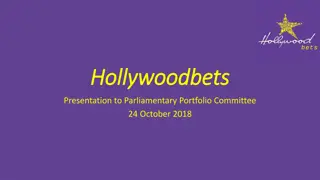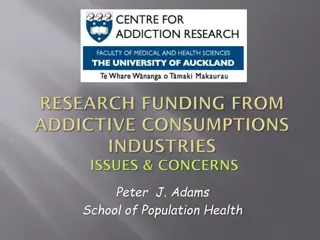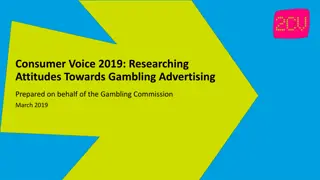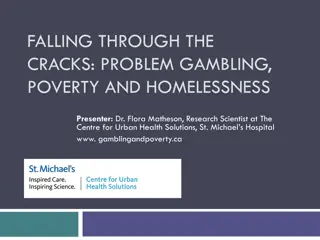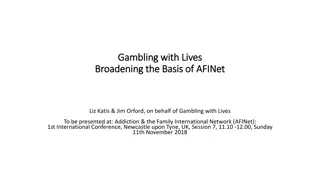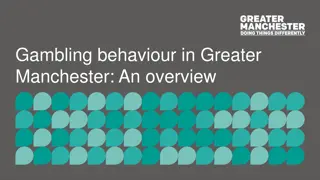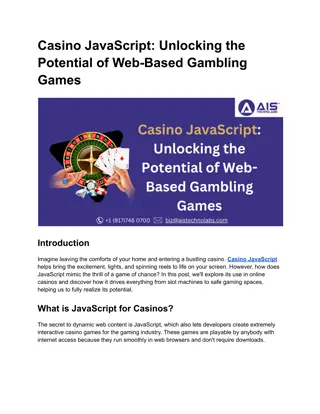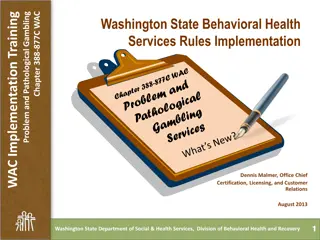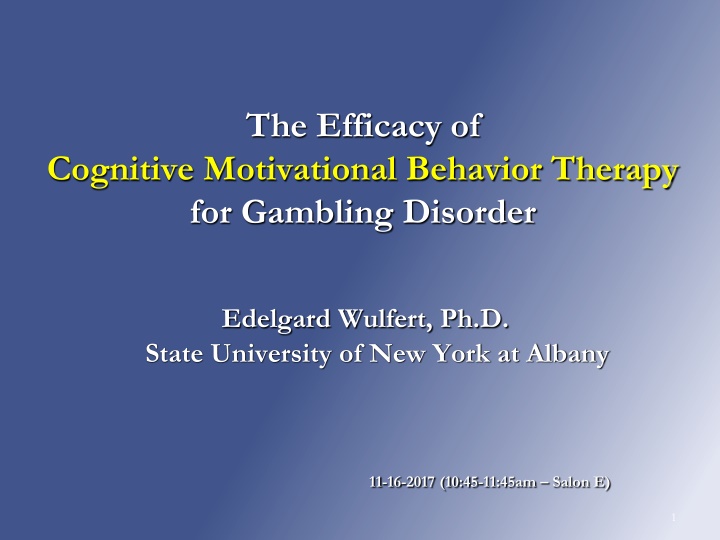
Effectiveness of Cognitive Behavioral Therapy for Gambling Disorder
Learn about the efficacy of Cognitive Behavioral Therapy (CBT) and Motivational Interviewing (MI) as effective treatments for gambling problems. Despite their proven effectiveness, issues such as high attrition rates and ambivalence among gamblers towards treatment highlight the urgent need for developing interventions that can better engage and retain patients in treatment.
Uploaded on | 0 Views
Download Presentation

Please find below an Image/Link to download the presentation.
The content on the website is provided AS IS for your information and personal use only. It may not be sold, licensed, or shared on other websites without obtaining consent from the author. If you encounter any issues during the download, it is possible that the publisher has removed the file from their server.
You are allowed to download the files provided on this website for personal or commercial use, subject to the condition that they are used lawfully. All files are the property of their respective owners.
The content on the website is provided AS IS for your information and personal use only. It may not be sold, licensed, or shared on other websites without obtaining consent from the author.
E N D
Presentation Transcript
The Efficacy of Cognitive Motivational Behavior Therapy for Gambling Disorder Edelgard Wulfert, Ph.D. State University of New York at Albany 11-16-2017 (10:45-11:45am Salon E) 1
Status of Treatment for Gambling Legislative Lifetime prevalence: Gambling disorder: ~0.5 1.0% Problem gambling: 2.0 4.0% Legislative changes: Proliferation of gambling venues (USA, CAN, AUS) Urgent need for effective treatments Treatment development in early stages 2
Research Findings Many studies are conceptually weak (variables are not well defined) Frequent methodological shortcomings (insufficient controls) Results are open to alternative interpretations 3
Research Findings Some well-controlled clinical trials exist Treatments with proven effectiveness: o Cognitive Behavior Therapy (CBT) o Motivational Interviewing (MI) Concern: o High attrition (treatment & follow-up) 4
Examples from the Literature Cognitive Behavioral Therapy (CBT) (Sylvain, Boisvert & Ladouceur, 1997) Randomized gamblers to CBT vs. wait list o ~ 1/3 dropped out from CBT o~ 1/2 made good progress o~ only 1/3 maintained treatment gains over 1 year 5
Examples from the Literature Purely Cognitive Therapy (CT) (Ladouceur et al., 2001) Replicated study with CT vs. wait list o Close to 1/2 dropped out of treatment o The other 1/2 made good progress and maintained treatment gains 6
Examples from the Literature Motivational Interviewing (MI) (Hodgins, Currie & El-Guebaly, 2001) Compared effects of - self-help workbook alone or - combined with a brief phone MI session o MI led to greater reduction in gambling o Effect dissipated over 12 months 7
Summary of Current Treatment Status o CBT and MI are effective treatments for gambling problems o However, gamblers are ambivalent about treatment and tend to drop out o Need to develop treatments to engage and retain patients in treatment 8
Cognitive-Motivational Behavior Therapy (CMBT) Empirically developed and researched psychotherapy (NIMH funded) CMBT integrates components of: o Motivational Interviewing (MI) o Cognitive Behavioral Therapy (CBT) o Behavior Therapy & Skills Training o Relapse Prevention 9
Aims of CMBT Generate motivation to stay in treatment (ambivalence drop-out) Correct cognitive distortions (cognitions behavior; magical solutions) Teach behavioral skills (coping & problem solving skills) Develop a relapse prevention plan (lapse vs. relapse) 10
MI Treatment Component Motivational Interviewing o Client-centered counseling style: oCollaborative oNon-judgmental oEvocative (directive) o Helps clients resolve ambivalence and engages them in treatment 11
Increasing Motivation Through Assessment-Based Feedback Presenting and Discussing Feedback: Client receives written summary of assessment results Feedback increases client s awareness of the full consequences of gambling 12
Decreasing Ambivalence via Decisional Balance Good Not So Good High Feeling Debt Way to get money Social Activity Heartache, Stress Sleepless nights Losing friends Becoming withdrawn Loss of Self-esteem Anxiety, Depression 13
Increasing Motivation through Value/Behavior Discrepancies Values Exercise: Client selects important values from a list (e.g., hard-working, good provider, good parent, trust- worthy ) Therapist facilitates discussion of discrepancy between espoused values and gambling behavior 14
Treatment Goal Setting When ambivalence has been resolved, client is asked to set treatment goals o Discuss possible hurdles and solutions o Abstinence vs. controlled gambling Proceed to next treatment phase: CBT o Cognitive and behavioral interventions 15
CBT Model Reciprocal relationships between components 16
Cognitive Interventions Identifying (external and internal) high-risk situations (triggers) that instill thoughts/urges to gamble Identifying cognitive distortions and automatic thoughts (e.g., gambler s fallacy) Using cognitive restructuring to correct false beliefs (Socratic method) Identifying and correcting Core Beliefs ( I m a failure money = love, power, respect = magical solution to life s problems ) 17
Behavioral Elements of CBT Teaching clients behavioral skills to avoid gambling o Avoiding high-risk situations o Managing Urges ( urge surfing ), stress, neg. mood o Problem solving (financial, work, relationships) Addressing relapse prevention o New behaviors, support networks, booster sessions 18
Research on CMBT Efficacy Study 1 (exploratory open trial) Comparing CMBT and TAU (trmt. as usual) CMBT: o 9 males (horse racing, BJ, craps gamblers) (2 males and 1 female did not participate in research) o Mean age 43 yrs (range: 27-56); 6 Cauc., 3 AA. o All met 7 of 10 DSM-IV criteria; Mean SOGS 16 TAU: (data retrieved from archives) o 12 males o Mean age 44 yrs (range: 30-59); 10 Cauc., 1AA, 1NA o All met 7.5 of 10 DSM-IV crit.; Mn SOGS 15 19
Attrition: CMBT vs. TAU CMBT: 9 of 9 retained TAU: 8 of 12 retained 2 (1, N=20)=8.05, p=.005 SOGS (before and after treatment): CMBT:Pre M=15.9 (SD 3.6); Post M=1.2 (SD 2.9)* TAU: Pre M=14.0 (SD 4.2); Post M=7.8 (SD 6.3)* Rep. Measures ANOVA (CMBT 3, 6, 12 mos): Time: Hot.Trace 7.25, F(1,15)=108.79, p<.001 Time*Group: Hot.Trace 1.17, F(1,15)=17.61, p=.001 DSM IV criteria (analogous findings) CMBT: Pre M=8.1 (SD 0.9); Post M=1.3 (SD 1.7)* TAU: Pre M=7.5 (SD 1.2); Post M=4.8 (SD 3.0)* Time: p<.001 and Time*Group Effect p=.002 * CMBT:TAU difference: p <.01 20
South Oaks Gambling Screen CMBT TAU 21
Research on CMBT Efficacy (RCT) Study 2 (NIMH-funded Randomized Controlled Trial) Comparing CMBT and GA (Gamblers Anonymous) Sample: o N=46 (32 males, 14 females) o Mean age 43 yrs (range: 24-70) o 39 Caucasian, 5 Afr.A., 1 Hisp., 1 Asian o Mean # DSM-IV criteria = 8; Mean SOGS 12 Randomized to Groups o CMBT:16 males, 7 females o GA: 16 males, 7 females 23
Attrition: CMBT vs. GA CMBT: 22 of 23 retained; attrition 4.3% GA: 14 of 23 retained; attrition 60.9% Fisher s Exact Test, p=.005 DMS IV: Patients who still met criteria for PG after treatment /3 mos/6 mos follow-up: CMBT:Post: 39% / 3 mos: 22% / 6 mos: 17% GA: Post: 70% / 3 mos: 57% / 6 mos: 65% Rep. Measures ANOVA (CMBT): Time*Group: Wilks .748, F(3,42)=4.73, p=.006 24
Percent Reduction in $$ Lost Gambling and Days Gambled From Pre-Treatment to 6 mos follow-up: % Reduction in dollars lost: % Reduction in days gambled: CMBT = 72% vs. GA = 8% ITT: Sign. for Condition, Time, Interaction (p<.01) CMBT = 79% vs. GA = 23% 25
Additional Findings: o No gender difference in CMBT: o Men and women benefited equally from treatment o Significant gender difference in GA: o None of the 7 women benefited from GA o The few men who remained with GA did as well as the men in CMBT 26
Effectiveness Trial (RCT) CMBT vs. CBT Study 3 (NIMH-funded Randomized Controlled Trial) Comparing CMBT and GBT Sample: o N=62 (44 males, 18 females) o Mean age 49 yrs (range: 20-76) o 51 Caucasian, 1 Afr.A., 2 Hisp., 3 Asian, 5 Other o Mean # DSM-IV criteria = 7; Mean SOGS 9 Randomized to Groups o CMBT:30 (21 males, 9 females) o GBT: 32 (23 males, 9 females) 27
Preliminary Findings DMS IV diagnostic criteria: o At the start of the trial, all patients met dx. criteria for pathological gambling o Patients in both CBT and CMBT improved significantly, with mean number of dx. criteria in the non-clinical range. o CMBT led to greater mean reductions in dx. criteria at 3, 6 and 12 mos follow-up (p .04) F(1, 176.62)=467, D=400, p=.032 28
Preliminary Findings Completion of all 12 sessions (Yes/No): CMBT: 21 of 30 (70%) completed all 12 sessions CBT: 18 of 33 (55%) completed all 12 sessions Is there a pattern to attrition? o CMBT emphasizes MI as an early engagement mechanism to prevent attrition 29
Survival Analysis of # of Sessions Completed Patients in CBT dropped out at higher rate than those in CMBT, particularly early in treatment. [Breslow (1) = 4.124, p=.042)] 30
Questions that need to be answered: Completion vs. benefit from treatment o Is there a dose-response relationship? Did patients with certain characteristics benefit more from one treatment than the other? o Matching hypothesis Did therapist competence play a role in outcomes or attrition? o Therapist effect o CBT: % Retention by Thpsts: 37 73 63 63 o CMBT: % 75 75 67 31
Additional Observations: After-care is important! o Refer clients to group (GA, self-help grp) o Provide booster sessions o Refer clients for treatment of comorbid psychological problems 32
Thank you for your attention. Questions? Comments? Contact Info: EWulfert@albany.edu 33

